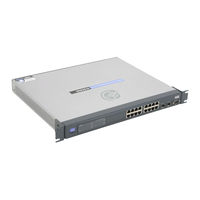Linksys SRW2016 Manuals
Manuals and User Guides for Linksys SRW2016. We have 5 Linksys SRW2016 manuals available for free PDF download: User Manual, Specifications
Advertisement
Linksys SRW2016 User Manual (123 pages)
24 or 48-Port 10/100 Fast Ethernet Switch, 16, 24, or 48-Port 10/100/1000 Gigabit Ethernet Switch
Table of Contents
Linksys SRW2016 User Manual (73 pages)
16- or 24-Port 10/100/1000 Gigabit Switch with WebView
Table of Contents
Advertisement
Linksys SRW2016 Specifications (3 pages)
BUSINESS SERIES 16-Port 10/100/1000 + 2-Port MiniGBIC Gigabit Switch with WebView
Linksys SRW2016 Specifications (2 pages)
16-Port 10/100/1000 Gigabit Switch
Advertisement




